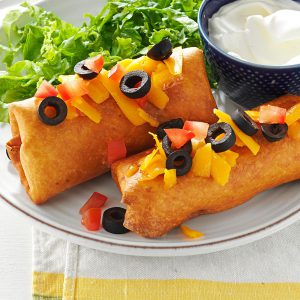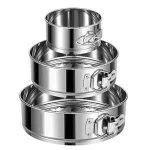Chimichangas

America's Contribution to Mexican Cuisine
Being raised in Texas I’m no stranger to Mexican food, as it’s readily available in just about every town and community, large or small, in the Lone Star state. From school cafeterias to mom and pop cafes, to regional chain restaurants and fast food joints, to food trucks and street carts, the abundance and variety of this popular cuisine is practically endless. From a very early age, my love for these spicy, earthy foods was as pronounced as that for the southern country favorites prepared by my mom.
During my time as a traveling chef for an international senior living company, one of my favorite on-the-road snack food was chimichangas—easy to eat while driving, not too messy, and a nice change from fast food burgers. Like many people, if not most, I always associated this deep-fried burrito as just another Americanized Mexican dish. Then while visiting one of my Arizona communities I was surprised to discover that the chimichanga is actually a hometown invention.
That’s right, the chimichanga is said to have been created not in Mexico but right there in Phoenix, Arizona U.S.A. . . . or, maybe it was Tucson. Then there’s the theory that Chinese immigrants from Baja are actually responsible for their existence. And like so many of our foods in America, exactly where and who invented the chimichanga is totally dependent upon which of these legends you choose to believe.
Legend 1 - Macayo’s Mexican Restaurant
According to family members, in 1946 Woody Johnson was looking for a way to extend the life of some unsold burritos at his first restaurant, El Nido, so he tossed a couple of them into the deep fryer. Wanting an opinion as to the success of this experiment, he gave one of the resulting crispy, golden brown burritos to a customer who immediately proclaimed it so good that he placed an order for the new item. When Johnson opened Macayo’s in 1952 his “fried burro” was prominently included at the top of his menu.
Today, the 14 Macayo’s in Arizona and four in Las Vegas are famous for their many varieties of the original chimichanga. And to celebrate this long-standing chimichanga legend, Macayo’s holds an annual “Chimi-Fiesta,” during which a dollar is donated to the Diamondbacks Foundation for each and every chimichanga sold.
Legend 2 - The El Charro story
As the story is told, in 1922 Monica Flin founded a small Mexican cafe called El Charro on North Court Avenue in Tucson, Arizona. One morning in 1951while preparing bean burritos for dinner service, Flin accidentally dropped one into the deep fryer. Her first reaction was to yell out chingada, a Spanish explicative cognate to the f-word, but because children were in the area, she called out “chimichanga” instead. When she fished out the burrito it turned out to be crispy and delicious, and a new dish was born.
Today El Charro, with five Tucson locations and a USDA-certified food factory, has the honor of being America’s oldest Mexican restaurant continuously owned by the original founder’s family.
Legend 3 - Enter the Chinese
This story comes by the way of Professor Francisco Paz, a geology instructor at the Universidad de Sonora. According to the Professor, chimichangas (or chivichangas as known in that state) were the results of the Mexican wives of Chinese workers trying to recreate Chinese food—namely egg rolls.
This legend becomes a bit more plausible when one considers that the word chimichanga has absolutely no roots in the Spanish language. However the Cantonese phrase “Gee May’s chun geen” (Gee May likely being the name of a food vendor and chun geen, Cantonese for egg roll) when said slowly certainly sounds roughly similar to Chimichangas, especially to the Mexican peoples ear and their tendency toward elision.
Without a doubt these are’t the only players laying claim to having invented the chimichanga. Others include Club 21, Mia Ranchito, and Micha’s, all in Phoenix. And then there are the claimers in Nogales, just across the Sonora-Arizona border—The Chimi Chango bar and La Frontera Restaurant. But the three most legendary claims are those described above.
So the next time your travels take you to Phoenix or Tucson we hope you’ll have an opportunity to visit one of these restaurants and enjoy a plate of the crispiest, tastiest chimichangas ever to pass between your lips.
And for those unable to make the trip to Arizona, you can take pleasure in knowing that those chimichangas you’re eating just might be as American as baseball, hot dogs, and apple pie.





